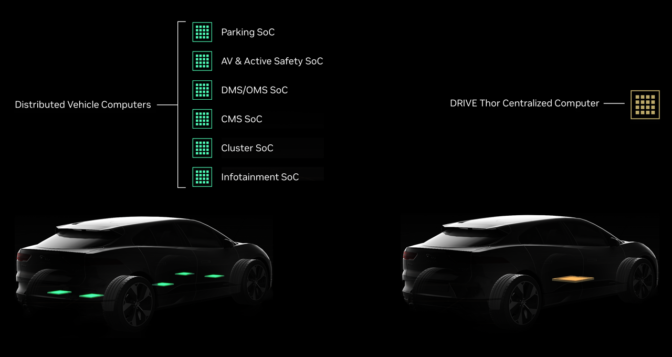The next generation of autonomous vehicle computing is improving performance and efficiency at the speed of light.
During today’s GTC keynote, NVIDIA founder and CEO Jensen Huang unveiled DRIVE Thor, a superchip of epic proportions. The automotive-grade system-on-a-chip (SoC) is built on the latest CPU and GPU advances to deliver 2,000 teraflops of performance while reducing overall system costs.
DRIVE Thor succeeds NVIDIA DRIVE Orin in the company’s product lineup, incorporating the newest compute technology to accelerate industry deployment of intelligent-vehicle technology, targeting automakers’ 2025 models.

Geely-owned premium EV maker ZEEKR will be the first customer for the next-generation platform, with production starting in 2025.
DRIVE Thor unifies traditionally distributed functions in vehicles — including digital cluster, infotainment, parking and assisted driving — for greater efficiency in development and faster software iteration.
Manufacturers can configure the DRIVE Thor superchip in multiple ways. They can dedicate all of the platform’s 2,000 teraflops to the autonomous driving pipeline, or use a portion for in-cabin AI and infotainment and another portion for driver assistance.
Like the current-generation NVIDIA DRIVE Orin, DRIVE Thor uses the productivity of the NVIDIA DRIVE software development kit, is designed to be ASIL-D functionally safe, and is built on a scalable architecture, so developers can seamlessly port their past software development to the latest platform.
Lightning Fast
In addition to raw performance, DRIVE Thor delivers an incredible leap in deep neural network accuracy.
DRIVE Thor marks the first inclusion of a transformer engine in the AV platform family. The transformer engine is a new component of the NVIDIA GPU Tensor Core. Transformer networks process video data as a single perception frame, enabling the compute platform to process more data over time.
With 8-bit floating point (FP8) precision, the SoC introduces a new data type for automotive. Traditionally, AV developers see a loss in accuracy when moving from 32-bit floating point to 8-bit integer data formats. FP8 precision eases this transition, making it possible for developers to transfer data types without sacrificing accuracy.
Additionally, DRIVE Thor uses updated ARM Poseidon AE cores, making it one of the highest performance processors in the industry.
Multi-Domain Computing
DRIVE Thor is as efficient as it is powerful.
The SoC is capable of multi-domain computing, meaning it can partition tasks for autonomous driving and in-vehicle infotainment. This multi-compute domain isolation lets concurrent time-critical processes run without interruption. On one computer, the vehicle can simultaneously run Linux, QNX and Android.
Typically, these types of functions are controlled by tens of electronic control units distributed throughout a vehicle. Rather than relying on these distributed ECUs, manufacturers can now consolidate vehicle functions using DRIVE Thor’s ability to isolate specific tasks.

All vehicle displays, sensors and more can connect to this single SoC, simplifying what has been an incredibly complex supply chain for automakers.
Two Is Always Better Than One
If one DRIVE Thor seems incredible, try two.
Customers can use one DRIVE Thor SoC, or they can connect two via the latest NVLink-C2C chip interconnect technology to serve as a monolithic platform that runs a single operating system.
This capability provides automakers with the compute headroom and flexibility to build software-defined vehicles that are continuously upgradeable through secure, over-the-air updates.
Designed with the best of NVIDIA GPU technology, DRIVE Thor is truly an AV SoC of heroic proportions.
The post NVIDIA DRIVE Thor Strikes AI Performance Balance, Uniting AV and Cockpit on a Single Computer appeared first on NVIDIA Blog.
